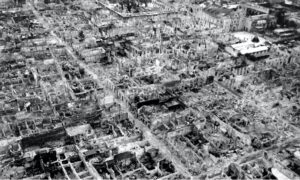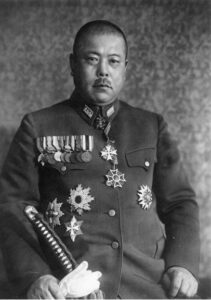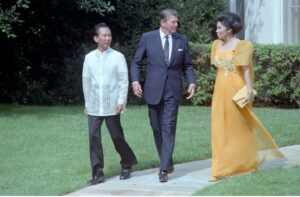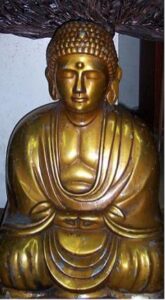I’ve been doing a lot of interviews around the publication of my novel Five Decembers, and one question I keep encountering is what I plan to write next. The true answer is, I’m not sure yet. But in all the research I did for my novel, I learned things that filled out the details of a tale I’d been aware of for a long time. It’s a war story and an international crime saga with connections to the Philippines, Japan and Hawaii. It stretches across eight decades, involves war crimes, torture, treasure, and courtroom drama.
I’m talking about the Yamashita Treasure, the Golden Buddha, and the everlasting Hawaii legal saga of Roxas v. Marcos. It’s a story so wild that if someone made it into a film, only Ennio Morricone could score it.
As with most histories, with this one, it’s hard to know where to start. Perhaps the best way to set the scene is in December of 1937, as the Imperial Japanese Army laid waste to Nanking. A New York Times reporter, writing later from the USS Oahu in Shanghai, described the carnage and plunder:
Any person who ran because of fear or excitement was likely to be killed on the spot as was any one caught by roving patrols in streets or alleys after dark. Many slayings were witnessed by foreigners.
The Japanese looting amounted almost to plundering of the entire city. Nearly every building was entered by Japanese soldiers, often under the eyes of their officers, and the men took whatever they wanted. The Japanese soldiers often impressed Chinese to carry their loot….
Just three decades earlier, Japan had won a surprise victory in the Russo-Japanese War. International observers were shocked not just because a previously closed-off and isolated Asian country had defeated a European power, but because it had done so with honor and strict adherence to the laws of war, such as they were. But the Japanese military of 1937 was not the same animal. By the time of Pearl Harbor, the Japanese imperial machine was well equipped to strip its new acquisitions of all their wealth and treasure. As Hong Kong, Malaya, Singapore, the Philippines and Guam fell in 1941 and 1942, the Japanese acted quickly to seize all currency and replace it with worthless Japanese Military Yen. Over $20 million in U.S. currency disappeared from Manila bank vaults in January 1942, which the Japanese used to purchase supplies in neutral countries.
In the Philippines, there was a lot to lose. Manila had been the Pearl of the Orient until December 1941. Its wide, tree-lined streets were studded with air conditioned department stores, international banks, and fashionable hotels servicing well-heeled travelers able to afford the steep price of a San Francisco to Manila ticket on the Pan Am China Clipper.
 The Pan Am China Clipper, which launched US – Manila service on Nov. 29, 1935. For its inaugural flight, it was navigated by Fred Noonan, who disappeared with Amelia Earhart in 1938.
The Pan Am China Clipper, which launched US – Manila service on Nov. 29, 1935. For its inaugural flight, it was navigated by Fred Noonan, who disappeared with Amelia Earhart in 1938.
The situation in Manila was grim after the invasion. But as the tide turned on the Japanese, it got a lot worse.
Ten days before the U.S. landings on Luzon, the Japanese sent in General Tomoyuki Yamashita—the Tiger of Malaya—to take command of the Fourteenth Army. General Yamashita ordered his men to fall back from Manila, rather than try to hold it, but a subordinate in the Navy had other plans. Rear Admiral Sanji Iwabuchi, who had previously been disgraced by the loss of a battleship at Guadalcanal, decided that the only way to save his honor would be to die in Manila—and take the city down with him. The month long Battle of Manila saw a hundred thousand civilians slaughtered, as the city was deliberately burned to the ground. It would be impossible to make a true tally of all that went missing in the flames.
 U.S. Army photograph—aftermath of Battle of Manila.
U.S. Army photograph—aftermath of Battle of Manila.
 General Tomoyuki Yamashita was executed for war crimes on February 23, 1946. Although he did not order the attrocities, he was found guilty under the principle of command responsibility, aka, the Yamashita Standard.
General Tomoyuki Yamashita was executed for war crimes on February 23, 1946. Although he did not order the attrocities, he was found guilty under the principle of command responsibility, aka, the Yamashita Standard.
Which is to say that by the time the smoke cleared and the world returned to peace, all conditions necessary for the creation of a myth were present. The legend of Yamashita’s Gold began to take shape: hidden beneath Luzon’s mountains were caves stacked full of gold bullion, looted jewels, and artifacts from all over Japan’s erstwhile empire.
In 1970, a young man named Rogelio Roxas obtained a treasure hunting permit at the Baguio City courthouse. The permit was signed by a local judge, Pio Marcos, who happened to be a relative of the President Ferdinand Marcos.
Roxas was by no means the only man looking for Yamashita’s Gold, but he had information others lacked: he claimed that in 1961, he’d met General Yamashita’s interpreter, who told him where to dig. Thus, in 1971, digging on public lands near the Baguio hospital, Roxas claims to have uncovered the opening to a cave. Descending inside, he found human skeletons, Japanese radios, samurai swords, and then a half-ton, 20-carat, golden Buddha statue. Not fantastic enough? Roxas also claimed the Buddha’s head was removable, and its hollow insides were filled with uncut diamonds. Still not impressed? Behind the Buddha was a large chamber, and it was filled with wooden crates. Roxas opened one crate and found 24 bars of gold.
Roxas (and presumably some friends) moved the Golden Buddha and a single crate of gold bars out of the cave, and back to his house in Baguio City, where he hid them in a closet. He posed for a newspaper photo with the Buddha, and started seeking buyers. Instead of a buyer, he got a midnight knock on the door from the goon squad.
They came in military garb, armed with guns. They also had a search warrant signed by Judge Pio Marcos. They took the Buddha, the gold bars, and all the cash and coins in the house. They beat up the family, and left.
Roxas went to the police station, and filed a complaint. He went to the press and told his story. A few weeks later, the military turned over a Buddha statue to the Baguio court, and Roxas claims he was pressured to sign an affidavit stating that he’d gotten his statue back. But he stuck to his guns: this wasn’t a half ton gold statue with a removable head, and it wasn’t full of diamonds. He wouldn’t sign. He was arrested, and beaten. They tortured him with wires hooked to a car battery; they put out their cigarettes on his skin. He escaped, but was arrested again. He didn’t get out until 1974.
 Friends in High Places — Ferdinand and Imelda Marcos at the White House in 1982.
Friends in High Places — Ferdinand and Imelda Marcos at the White House in 1982.
Once free, Roxas kept his head down, and bided his time. In 1986, Marcos lost power in a snap election. In a move that might seem familiar, he claimed he was the actual winner and was unfairly deprived of the presidency. He considered invoking martial law, but ultimately fled the country with the help of the United States. He and his wife, Imelda, boarded an American C-130 and escaped to Hawaii. Their luggage consisted of 22 crates of cash ($717 million), along with:
300 crates of assorted jewelry with undetermined value, $4 million worth of unset precious gems contained in Pampers diaper boxes, 65 Seiko and Cartier watches, a 12 by 4 ft box crammed full of real pearls, a 3 ft solid gold statue covered in diamonds and other precious stones, $200,000 in gold bullion and nearly $1 million in Philippine pesos, and deposit slips to banks in the US, Switzerland, and the Cayman Islands worth $124 million.
With Marcos out of power and subject to United States jurisdiction, in 1988 Roxas made his move. He transferred his rights to the treasure to the Golden Buddha Corporation, which then filed suit in Hawaii state court seeking damages for theft of the Yamashita Gold and the Golden Buddha. Marcos died in Hawaii in 1989, and his estate (with Imelda Marcos as its personal representative) was substituted as the defendant.
Roxas also died before the trial. This was in 1993, and he was in the Philippines. Apparently, there was no autopsy. Honolulu legal circles still swirl with rumors about this. He drowned in a bathtub. No—he died of tuberculosis. It was a hit; it was a freak accident. No one knows. Regardless, Roxas’s deposition testimony was allowed into the trial. In 1996, the court returned a verdict in favor of Roxas, and it was a whopper. At $22 billion, with interest accruing, it was the largest civil damages award ever handed down in the United States, and it was based on the assumption that if Roxas had opened every box in the cave, he would have found 24 gold bars in each box. Then the jury was allowed to guess at how many boxes might have been in the cave. Unsurprisingly, Marcos got the damages award reversed on appeal. It was reduced to $6 million, for Roxas’s unlawful arrest and torture. Squabbles over this went on for so long that my wife—who was three years old when Marcos fled to Hawaii—eventually became one of the attorneys representing Imelda Marcos. (I always got a kick out of this, because when I met her in law school, she had an entire walk-in closet full of shoes, which I called the Imelda Room).
While it appears to be a settled decision of a U.S. court that the Yamashita Gold exists, courts in the Philippines have scoffed at this. A 1996 Philippine case held that the bronze Buddha statue returned to Roxas in 1971 was the same one that he’d found. That bronze statue is still in the Baguio court, waiting for the Roxas family to claim it.
 Credit: Keith Brooks
Credit: Keith Brooks
Tales of buried Japanese gold abound throughout the Pacific. When I lived in Taiwan—a former Japanese colony—I heard rumors of lost tunnel complexes in the mountains east of Hsinchu. I never found one, but I always kept an eye to the ground. (And not just for tunnels: there was also a rumor that the Japanese had released every known species of poisonous snake in Taiwan, after abandoning a bioweapons lab).
Did Roxas strike it lucky on a dig in Baguio? Or did he only strike gold in a Honolulu courtroom? I don’t know. But I would love it if someone would get a shovel and go deeper.
***


















